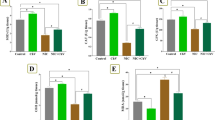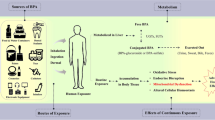Abstract
To investigate the effect of enzymatically modified isoquercitrin (EMIQ) on hepatocellular tumor promotion induced by phenobarbital (PB), male rats were administered a single intraperitoneal injection of 200 mg/kg N-diethylnitrosamine (DEN) and then fed with a diet containing PB (500 ppm) for 8 weeks, with or without EMIQ (2,000 ppm) in the drinking water. One week after PB administration, rats underwent a two-thirds partial hepatectomy. The PB-induced increase in the number and area of glutathione S-transferase placental form-positive foci and the proliferating cell nuclear antigen-positive ratio was significantly suppressed by EMIQ. Real-time reverse transcription–polymerase chain reaction analysis revealed increases in mRNA expression levels of Cyp2b2 and Mrp2 in the DEN-PB and DEN-PB-EMIQ groups compared with the DEN-alone group, while the level of Mrp2 decreased in the DEN-PB-EMIQ group compared with the DEN-PB group. There were no significant changes in microsomal reactive oxygen species (ROS) production and oxidative stress markers between the DEN-PB and DEN-PB-EMIQ groups. Immunohistochemically, the constitutive active/androstane receptor (CAR) in the DEN-PB group was clearly localized in the nuclei, but its immunoreactive intensity was decreased in the DEN-PB-EMIQ group. These results indicate that EMIQ suppressed the liver tumor-promoting activity of PB by inhibiting nuclear translocation of CAR, and not by suppression of oxidative stress.


Similar content being viewed by others
References
Adams TB, McGowen MM, Williams MC, Cohen SM, Feron VJ, Goodman JI, Marnett LJ, Munro IC, Portoghese PS, Smith RL, Waddell WJ (2007) The FEMA GRAS assessment of aromatic substituted secondary alcohols, ketones, and related esters used as flavor ingredients. Food Chem Toxicol 45:171–201
Akiyama T, Washino T, Yamada T, Koda T, Maitani T (2000) Constituents of enzymatically modified isoquercitrin and enzymatically modified rutin (extract). J Food Hyg Soc Jpn 41:54–60
Alcorn JA, Feitelberg SP, Brenner DA (1990) Transient induction of c-jun during hepatic regeneration. Hepatology 11:909–915
Coni P, Simbula G, de Prati AC, Menegazzi M, Suzuki H, Sarma DS, Ledda-Columbano GM, Columbano A (1993) Differences in the steady state levels of c-fos, c-jun and c-myc messenger RNA during mitogen-induced liver growth and compensatory regeneration. Hepatology 17:1109–1116
Deguchi Y, Yamada T, Hirose Y, Nagahori H, Kushida M, Sumida K, Sukata T, Tomigahara Y, Nishioka K, Uwagawa S, Kawamura S, Okuno Y (2009) Mode of action analysis for the synthetic pyrethroid metofluthrin-induced rat liver tumors: evidence for hepatic CYP2B induction and hepatocyte proliferation. Toxic Sci 108:69–80
Dewa Y, Nishimura J, Muguruma M, Jin M, Saegusa Y, Okamura T, Tasaki M, Umemura T, Mitsumori K (2008) β-Naphthoflavone enhances oxidative stress responses and the induction of preneoplastic lesions in a diethylnitrosamine-initiated hepatocarcinogenesis model in partially hepatectomized rats. Toxicology 244:179–189
Dewa Y, Nishimura J, Muguruma M, Jin M, Kawai M, Saegusa Y, Okamura T, Umemura T, Mitsumori K (2009) Involvement of oxidative sterss in hepatocellular tumor-promoting activity of oxfendazole in rats. Arch Toxicol 83:503–511
Facchini LM, Penn LZ (1998) The molecular role of Myc in growth and transformation: recent discoveries lead to new insights. FASEB J 12:633–651
Feldman D, Swarm R, Becker J (1981) Ultrastructural study of rat liver neoplasms after long-term treatment with phenobarbital. Cancer Res 41:2151–2162
Formica JV, Regelson W (1995) Review of the biology of quercetin and related bioflavonoids. Food Chem Toxicol 33:1061–1080
Helbock HJ, Beckman KB, Shigenaga MK, Walter PB, Woodall AA, Yeo HC, Ames BN (1998) DNA oxidation matters: the HPLC-electrochemical detection assay of 8-oxo-deoxygnanosine and 8-oxo-deoxyguanine. Proc Natl Acad Sci USA 95:228–293
Honkakoski P, Zelko I, Sueyoshi T, Neghishi M (1998) The nuclear orphan receptor CAR-retinoid X receptor heterodimer activates the phenobarbital-responsive enhancer module of the CYP2B gene. Mol Cell Biol 18:5652–5658
Imaoka S, Osada M, Minamiyama Y, Yukimura T, Toyokuni S, Takemura S, Hiroi T, Funae Y (2004) Role of phenobarbital-inducible cytochrome P450 s as a source of active oxygen species in DNA-oxidation. Cancer Lett 203:117–125
Inoue J, Gohda J, Akiyama T, Semba K (2007) NF-kappaB activation in development and progression of cancer. Cancer Sci 98:268–274
Jancova P, Anzenbacher P, Anzenbacherova E (2010) Phase II drug metabolizing enzymes. Biomed Pap Med Fac Univ Palacky Olomouc Czech Repub 154:103–116
Japanese Ministry of Health and Welfare (1996) The list of existing food additives. Japanese Ministry of Health and Welfare, Tokyo. (Notification No. 120)
Kawamoto T, Sueyoshi T, Zelko I, Moore R, Washburn K, Negishi M (1999) Phenobarbital-responsive nuclear translocation of the receptor CAR in induction of the CYP2B gene. Mol Cell Biol 19:6318–6322
Kinoshita A, Wanibuchi H, Imaoka S, Ogawa M, Masuda C, Morimura K, Funae Y, Fukushima S (2002) Formation of 8-hydroxydeoxyguanosine and cell-cycle arrest in the rat liver via generation of oxidative stress by phenobarbital: association with expression profiles of p21(WAF1/Cip1), cyclin D1 and Ogg1. Carcinogenesis 23:341–349
Kruijer W, Skelly H, Bltteri F, Van der Putten H, Barber JR, Verma IM, Leffert LH (1986) Proto-oncogene expression in regenerating liver is simulated in cultures of primary adult rat hepatocytes. J Biol Chem 261:7929–7933
Kwan P, Brodie MJ (2004) Phenobarbital for the treatment of epilepsy in the 21st Century: a critical review. Epilepsia 45:1141–1149
Maglich JM, Stoltz CM, Goodwin B, Brown DH, Moore JT, Kliewer SA (2002) Nuclear pregnane X receptor and constitutive androstane receptor regulate overlapping but distinct sets of genes involved in xenobiotic detoxification. Mol Pharmacol 62:638–646
Malumbres M, Barbacid M (2009) Cell cycle, CDKs and cancer: a changing paradigm. Nat Rev Cancer 9:153–166
McDonald ER III, El-Deiry WS (2000) Cell cycle control as a basis for cancer drug development (Review). Int J Oncol 16:871–886
McLaughlin MM, Kumar S, McDonnell PC, Horn SV, Lee JC, Livi GP, Young PR (1996) Identification of mitogen-activated protein (MAP) kinase-activated protein kinase-3, a novel substrate of CSBP p38 MAP kinase. J Biol Chem 271:8488–8492
Muguruma M, Unami A, Kanki M, Kuroiwa Y, Nishimura J, Dewa Y, Umemura T, Oishi Y, Mitsumori K (2007) Possible involvement of oxidative stress in piperonyl butoxide induced hepatocarcinogenesis in rats. Toxicology 236:61–75
Muguruma M, Kawai M, Dewa Y, Nishimura J, Saegusa Y, Yasuno H, Jin M, Matsumoto S, Takabatake M, Arai K, Mitsumori K (2009) Threshold dose of piperonyl butoxide that induces reactive oxygen species-mediated hepatocarcinogenesis in rats. Arch Toxicol 83:183–193
Nishikawa T, Wanibuchi H, Ogawa M, Kinoshita A, Morimura K, Hiroi T, Funae Y, Kishida H, Nakae D, Fukushima S (2002) Promoting effects of monomethylarsonic acid, dimethylarsinic acid and trimethylarsine oxide on induction of rat liver preneoplastic glutathione S-transferase placental form positive foci: a possible reactive oxygen species mechanism. Int J Cancer 100:136–139
Nishimura J, Saegusa Y, Dewa Y, Jin M, Kawai M, Kemmochi S, Harada T, Hayashi S, Shibutani M, Mitsumori K (2010) Antioxidant enzymatically modified isoquercitrin or melatonin supplementation reduces oxidative stress- mediated hepatocellular tumor promotion of oxfendazole in rats. Arch Toxicol 84:143–153
O’Farrel PP (2001) Triggering the all-or-nothing switch into mitosis. Trends Cell Biol 11:512–519
Ohkawa H, Ohnishi N, Yagi K (1979) Assay for lipid peroxides in animal tissues by thiobarbituric acid reaction. Anal Biochem 95:351–358
Peraino C, Fry RJM, Staffeldt EF (1978) Reduction and enhancement by phenobarbital of hepatocarcinogenesis induced in the rat by 2-acetylaminofluorene. Cancer Res 31:1506–1512
Phillips JM, Burgoon LD, Goodman JI (2009) The constitutive active/androstane receptor facilitates unique phenobarbital–induced expression changes of genes involved in key pathways in precancerous liver and liver tumors. Toxic Sci 110:319–333
Puntarulo S, Cederbaum AI (1998) Production of reactive oxygen species by microsomes enriched in specific human cytochrome P450 enzymes. Free Radic Biol Med 24:1324–1330
Rosenfeld JM, Vargas R Jr, Xie W, Evans RM (2003) Genetic profiling defines the xenobiotic gene network controlled by the nuclear receptor pregnane X receptor. Mol Endocrinol 17:1268–1282
Sansregret L, Gallo D, Santaguida M, Leduy L, Harada R, Nepveu A (2010) Hyperphosphorylation by cyclin D/CDK1 in mitosis resets CUX1 DNA binding clock at each cell cycle. J Biol Chem 285:32834–32843
Serron SC, Dwivedi N, Backes WL (2000) Ethylbenzene induces microsomal oxygen free radical generation: antibody-directed characterization of the responsible cytochrome P450 enzymes. Toxicol Appl Pharmacol 164:305–311
Shelby MK, Kalaassen CD (2006) Induction of rat UDP-glucuronosyltransferases in liver and duodenum by microsomal enzyme inducers that activate various transcriptional pathways. Drug Metabol Dispos 34:1772–1778
Smith RL, Cohen SM, Doull J, Feron VJ, Goodman JI, Marnett LJ, Munro IC, Portoghese PS, Waddell WJ, Wagner BM, Adams TB (2005) Criteria for the safety evaluation of flavoring substances: The Expert Panel of the Flavor and Extract Manufacturers Association. Food Chem Toxicol 43:1141–1177
Sueyoshi T, Kawamoto T, Zelko I, Honkakoshi P, Negishi M (1999) The repressed nuclear receptor CAR responds to phenobarbital in activating the human CYP2B6 gene. J Biol Chem 274:6043–6046
Umemura T, Kuroiwa Y, Kitamura Y, Ishii Y, Kanki K, Kodama Y, Itoh K, Yamamoto M, Nishikawa A, Hirose M (2006) A crucial role of Nrf2 in in vivo defense against oxidative damage by an environmental pollutant, pentachlorophenol. Toxicol Sci 90:111–119
U.S. Food and Drug Administration (2007) Agency response letter GRAS notice No. GRN 000220 [alpha-glycosyl isoquercitrin]. U.S. Food and Drug Administration Center for Food Safety and Applied Nutrition. Retrieved October 1, 2010, from http://www.fda.gov/Food/FoodIngredientsPackaging/GenerallyRecognizedasSafeGRAS/GRASListings/ucm153867.htm
Wang H, LeCluyse EL (2003) Role of orphan nuclear receptors in the regulation of drug-metabolising enzymes. Clin Pharmacokinet 42:1331–1357
Waxman DJ, Azaroff L (1992) Phenobarbital induction of cytochrome P-450 gene expression. Biochem J 281:577–592
White KL, Vierkant RA, Phelan CM, Fridley BL, Anderson S, Knutson KL, Schildkraut JM, Cunningham JM, Kelemen LE, Pankrats VS, Rider DN, Liebou M, Hartmann LC, Sellers TA, Goode EL (2009) Polymorphisms in NF-kappaB inhibitors and risk of epithelial ovarian cancer. BMC Cancer 9:170
Xie W, Yeuh M, Pandya AR, Saini SPS, Negishi Y, Bottroff BS, Cabrera Y, Tukey RH, Evans RM (2002) Control of steroid, heme, and carcinogen metabolism by nuclear pregnane X receptor and constitutive androstane receptor. PNAS 100:4150–4155
Yamamoto Y, Moore R, Goldsworthy TL, Negishi M, Maronpot RR (2004) The orphan nuclear receptor constitutive active/androstane receptor is essential for liver tumor promotion by phenobarbital in mice. Cancer Res 64:7197–7200
Yokohira M, Yamakawa K, Saoo K, Matsuda Y, Hosokowa K, Hashimoto N, Kuno T, Imaeda K (2008) Antioxidant effects of flavonoids used as food additives (purple corn color, enzymatically modified isoquercitrin, and isoquercitrin) on liver carcinogenesis in a rat medium-term bioassay. J Food Sci 73:561–568
Yoshihara S, Makishita M, Suauki N, Ohta S (2001) Metabolic activation of bisphenol A by rat liver S9 fraction. Toxicol Sci 62:221–227
Yueh MF, Tukey RH (2007) Nrf2-Keap1 signaling pathway regulates human UGT1A1 expression in vitro and in transgenic UGT1 mice. J Biol Chem 282:8749–8758
Zelko I, Sueyoshi T, Kawamoto T, Moore R, Negishi M (2001) The peptide near the C terminus regulates receptor car nuclear translocation induced by xenochemicals in mouse liver. Mol Cell Biol 21:2838–2846
Author information
Authors and Affiliations
Corresponding author
Rights and permissions
About this article
Cite this article
Morita, R., Shimamoto, K., Ishii, Y. et al. Suppressive effect of enzymatically modified isoquercitrin on phenobarbital-induced liver tumor promotion in rats. Arch Toxicol 85, 1475–1484 (2011). https://doi.org/10.1007/s00204-011-0696-z
Received:
Accepted:
Published:
Issue Date:
DOI: https://doi.org/10.1007/s00204-011-0696-z




